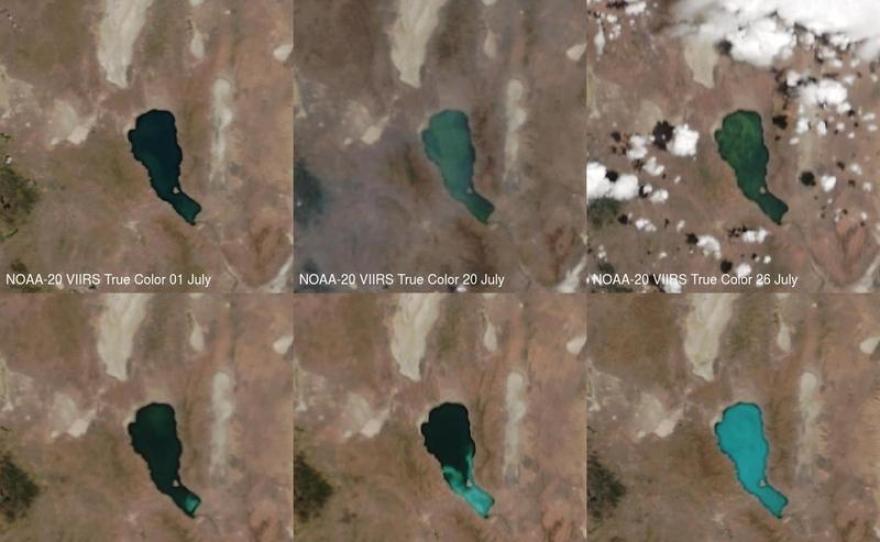Two separate times over the summer, the City of Reno in Nevada warned residents to avoid contact with local lakes and ponds where the explosive growth of cyanobacteria – also known as blue-green algae – had choked the water with green slime and released dangerous toxins.
These algal blooms happen when warm weather combines with high concentrations of nutrients and stagnant water to create the perfect conditions for aquatic microorganisms to take over.
“In periods of drought, like we’re having now, they occur more frequently,” said Theresa Jones.
Jones is an environmental engineer for Reno’s Public Works Department, where she monitors urban waterways. She says the last time Reno had to issue a public advisory about algal blooms was in 2015, during the last dry spell. That’s because Virginia Lake and the Paradise Park Ponds receive water from the Truckee River, the region’s main water source.
During the years when it runs low, that supply gets turned off. As a result, there’s no fresh water to dilute the algae or the nutrients that help it grow, like fertilizers that get washed into lakes by rain and melting snow.
None of the public bodies of water in Reno are designed for swimming, so the risk to residents is low, but the toxins released by cyanobacteria can be fatal to dogs.
According to Sudeep Chandra of the Global Water Center at the University of Nevada, Reno, algal blooms aren’t limited to urban waterways.
“We’re seeing excessive algal growth in Lake Tahoe from time to time, but we’re also seeing it back east in the eastern Great Basin and the Great Salt Lake,” he said.
As climate change leads to higher temperatures and prolonged drought in the West, Chandra says such imbalances are becoming increasingly common.
“It facilitates the right conditions for certain types of algae to bloom,” he said. “So it’s predicted that with future changes in climate and changes in how we manage our watersheds – maybe development or nutrient runoff – that we’ll see increased algal blooms into the future.”
Chandra also says human activities make it more likely for algae to explode in other ways. For example, the West’s growing population puts greater pressure on already-stressed rivers, lakes and reservoirs. Invasive species like crayfish contribute, too, by adding even more nutrients to the water as they graze along the bottom.
“All things must poop,” Chandra explained.
But even remote lakes are seeing more and more algal growth.
Jill Baron is a senior scientist with the U.S. Geological Survey and a researcher at Colorado State University, where she’s been studying the Loch Vale Watershed in Rocky Mountain National Park since 1983. As part of that research, Baron and her colleagues have taken core samples of sediment at the bottom of lakes that lie more than 10,000 feet above sea level. The data they’ve collected from the mud goes back 14,000 years.
She says the amount of algae in those lakes was stable until the 1950s, when they noticed an abrupt increase. That corresponds with increased use of irrigation and fertilizers in the region and explosive growth in the population around Denver. As a result, emissions from agriculture and transportation rose drastically. That air pollution includes nitrogen – a common ingredient in commercial fertilizers.
“Nitrogen emissions get up in the atmosphere, they travel to Rocky Mountain National Park and they fall out of the sky,” she said. “They actually are causing a fertilization effect.”
Baron also says changes in land use, coupled with extreme drought, are driving algal growth.
Across the Intermountain West, soils have been disturbed by ranching, development, recreation, and oil and gas exploration. At the same time, declining precipitation and a rise in water use for irrigation and new development have made bodies of water like the Great Salt Lake recede, exposing fine sediment that once lay underwater.
The wind carries that dust, which contains phosphorus, and deposits it on snow in the Rockies. That becomes additional fertilizer for algae in the watershed once the snow melts. Meanwhile, the water in those lakes has warmed by about four degrees.
Baron and her students followed up on those discoveries with a series of experiments aimed at teasing apart the specific impact of each environmental change on the Loch Vale Watershed.
“Temperature increases the growth of algae dramatically, but nutrients change the species that are able to take advantage of that growth,” she said. “Both of those are required to explain what we’re seeing. But warming alone would increase productivity.”
Still, Sudeep Chandra says more research is needed to determine the long-term impacts of algal blooms on aquatic ecosystems. For one thing, some types of algae and cyanobacteria can fix nitrogen in the system, which benefits other species. They also form the base of the food chain.
“Don’t forget to hug your algae a little bit,” he said. “Because sometimes they’re really good for the environment as well.”
Even the cyanobacteria that can release toxins don’t always do so, although Chandra says scientists don’t fully understand why. But he says it’s still a good idea to listen to public health warnings when algae takes over the local swimming hole.
Algal blooms don’t last forever, either: As the weather changes and temperatures drop, that green slime will start to go away.
This story was produced by the Mountain West News Bureau, a collaboration between Wyoming Public Media, Nevada Public Radio, Boise State Public Radio in Idaho, KUNR in Nevada, the O'Connor Center for the Rocky Mountain West in Montana, KUNC in Colorado, KUNM in New Mexico, with support from affiliate stations across the region. Funding for the Mountain West News Bureau is provided in part by the Corporation for Public Broadcasting.


